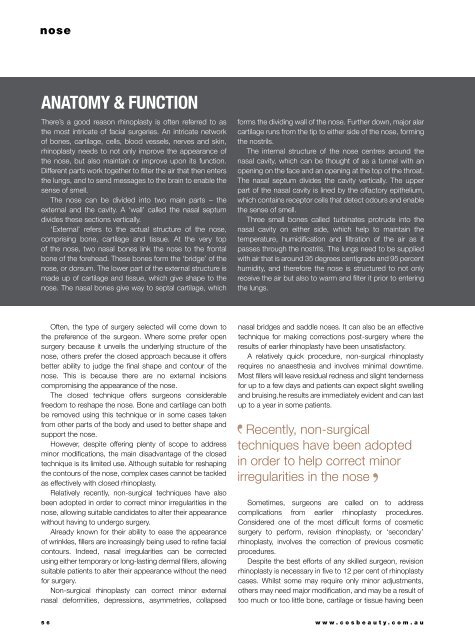Cosmetic Surgery and Beauty Magazine #68
You also want an ePaper? Increase the reach of your titles
YUMPU automatically turns print PDFs into web optimized ePapers that Google loves.
nose<br />
Anatomy & Function<br />
There’s a good reason rhinoplasty is often referred to as<br />
the most intricate of facial surgeries. An intricate network<br />
of bones, cartilage, cells, blood vessels, nerves <strong>and</strong> skin,<br />
rhinoplasty needs to not only improve the appearance of<br />
the nose, but also maintain or improve upon its function.<br />
Different parts work together to filter the air that then enters<br />
the lungs, <strong>and</strong> to send messages to the brain to enable the<br />
sense of smell.<br />
The nose can be divided into two main parts – the<br />
external <strong>and</strong> the cavity. A ‘wall’ called the nasal septum<br />
divides these sections vertically.<br />
‘External’ refers to the actual structure of the nose,<br />
comprising bone, cartilage <strong>and</strong> tissue. At the very top<br />
of the nose, two nasal bones link the nose to the frontal<br />
bone of the forehead. These bones form the ‘bridge’ of the<br />
nose, or dorsum. The lower part of the external structure is<br />
made up of cartilage <strong>and</strong> tissue, which give shape to the<br />
nose. The nasal bones give way to septal cartilage, which<br />
forms the dividing wall of the nose. Further down, major alar<br />
cartilage runs from the tip to either side of the nose, forming<br />
the nostrils.<br />
The internal structure of the nose centres around the<br />
nasal cavity, which can be thought of as a tunnel with an<br />
opening on the face <strong>and</strong> an opening at the top of the throat.<br />
The nasal septum divides the cavity vertically. The upper<br />
part of the nasal cavity is lined by the olfactory epithelium,<br />
which contains receptor cells that detect odours <strong>and</strong> enable<br />
the sense of smell.<br />
Three small bones called turbinates protrude into the<br />
nasal cavity on either side, which help to maintain the<br />
temperature, humidification <strong>and</strong> filtration of the air as it<br />
passes through the nostrils. The lungs need to be supplied<br />
with air that is around 35 degrees centigrade <strong>and</strong> 95 percent<br />
humidity, <strong>and</strong> therefore the nose is structured to not only<br />
receive the air but also to warm <strong>and</strong> filter it prior to entering<br />
the lungs.<br />
Often, the type of surgery selected will come down to<br />
the preference of the surgeon. Where some prefer open<br />
surgery because it unveils the underlying structure of the<br />
nose, others prefer the closed approach because it offers<br />
better ability to judge the final shape <strong>and</strong> contour of the<br />
nose. This is because there are no external incisions<br />
compromising the appearance of the nose.<br />
The closed technique offers surgeons considerable<br />
freedom to reshape the nose. Bone <strong>and</strong> cartilage can both<br />
be removed using this technique or in some cases taken<br />
from other parts of the body <strong>and</strong> used to better shape <strong>and</strong><br />
support the nose.<br />
However, despite offering plenty of scope to address<br />
minor modifications, the main disadvantage of the closed<br />
technique is its limited use. Although suitable for reshaping<br />
the contours of the nose, complex cases cannot be tackled<br />
as effectively with closed rhinoplasty.<br />
Relatively recently, non-surgical techniques have also<br />
been adopted in order to correct minor irregularities in the<br />
nose, allowing suitable c<strong>and</strong>idates to alter their appearance<br />
without having to undergo surgery.<br />
Already known for their ability to ease the appearance<br />
of wrinkles, fillers are increasingly being used to refine facial<br />
contours. Indeed, nasal irregularities can be corrected<br />
using either temporary or long-lasting dermal fillers, allowing<br />
suitable patients to alter their appearance without the need<br />
for surgery.<br />
Non-surgical rhinoplasty can correct minor external<br />
nasal deformities, depressions, asymmetries, collapsed<br />
nasal bridges <strong>and</strong> saddle noses. It can also be an effective<br />
technique for making corrections post-surgery where the<br />
results of earlier rhinoplasty have been unsatisfactory.<br />
A relatively quick procedure, non-surgical rhinoplasty<br />
requires no anaesthesia <strong>and</strong> involves minimal downtime.<br />
Most fillers will leave residual redness <strong>and</strong> slight tenderness<br />
for up to a few days <strong>and</strong> patients can expect slight swelling<br />
<strong>and</strong> bruising.he results are immediately evident <strong>and</strong> can last<br />
up to a year in some patients.<br />
Recently, non-surgical<br />
techniques have been adopted<br />
in order to help correct minor<br />
irregularities in the nose<br />
Sometimes, surgeons are called on to address<br />
complications from earlier rhinoplasty procedures.<br />
Considered one of the most difficult forms of cosmetic<br />
surgery to perform, revision rhinoplasty, or ‘secondary’<br />
rhinoplasty, involves the correction of previous cosmetic<br />
procedures.<br />
Despite the best efforts of any skilled surgeon, revision<br />
rhinoplasty is necessary in five to 12 per cent of rhinoplasty<br />
cases. Whilst some may require only minor adjustments,<br />
others may need major modification, <strong>and</strong> may be a result of<br />
too much or too little bone, cartilage or tissue having been<br />
56 www.cosbeauty.com.au


















